

We have been traversing the South Pacific for over thirty days now. Early on, we had several days of high winds and rough seas with waves that may have been as big as 8 meters (over 25 feet). The bow of this gigantic vessel would sometimes submerge under a giant wave that sent thumps and reverberations throughout the hull of the ship. During those days, giant albatross followed the ship and showed off their flying skills. They would glide with great speed over the peaks of these waves and down into the troughs. At the bottom, they would make a sharp turn and catch the air current generated by the water motion and appeared as if they were surfing along the face of the wave.
We’ve crossed several time zones and, for the first time in my life, I have experienced ‘boat lag’ and had to adjust my sleeping to compensate for the changes. It is difficult to distinguish one day from the other. Each morning I rise, have my coffee, and read the news via AP wire. After grabbing some breakfast, I prepare all of the filtration equipment in the lab. Next, I clean, adjust, and focus the FlowCam, an instrument used to image microscopic organisms in the water. Usually by the time that is completed we are on station (our daily stop to lower the instruments down deep into the ocean). We get suited up into our protective gear then go out on the back deck to deploy our instruments and pump sea water into large Nalgene containers with a spigot to dispense the water. We bring the water samples into the lab and spend hours filtering the water through different types of filters.
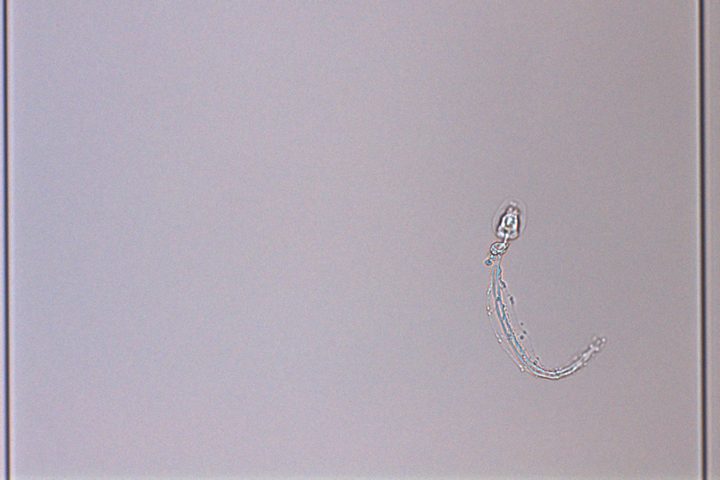
A transparent marine worm, called Chaetognatha, seen through our flow through imaging system (FlowCam). Credit: Mike Novak/NASA
Back in the labs at NASA Goddard, we will analyze the particles that got trapped on the filters as well as what went through, or the dissolved portion. It’s all valuable information about the microscopic life in this part of the ocean and helps us understand the role each plays in Earth’s carbon cycle.
The days here are long and repetitive. Sometimes I’m on my feet almost nonstop for 10-12 hours. When seas are rough, the boat is constantly moving and I have to compensate all the time for that movement while I stand, move, or walk. There are crew members, engineers, marine technicians, and scientists from many disciplines and institutions on this expedition. Everyone works hard and does their best to keep morale and spirits up. People organize cribbage and ping pong tournaments. Sometimes it is hard to find the time where shifts and availability match up to compete, but it is a good way to have some fun if you can find some down time.
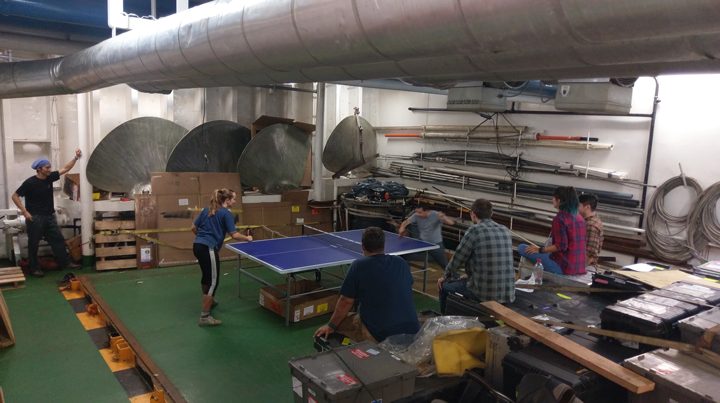
When the seas are calm and daily duties are done, people play ping-pong inside the ship. Credit: Mike Novak/NASA
On clear nights, I go out on deck where the stars can be so magnificent and I gaze deep into the universe. The Milky Way stretches across the sky from horizon to horizon. Since we are in the southern hemisphere, we see many constellations and celestial objects that people in the northern hemisphere cannot see. The Southern Cross is a very prominent constellation while the two Magellanic Clouds are neighboring galaxies that are an impressive sight, even with the naked eye. In the south, the image of the moon is inverted compared to viewing it from the north. The new crescent moon waxes, or increases size, from the left to right instead of the reverse direction that I’m used to seeing back home.
An unobstructed view of sunsets and sunrises over the ocean are an inspiration to see. Many of us try to meet out on the helipad after dinner to watch the sun dip below the horizon. When the clouds are positioned just right, it appears as if they become electrified and the sky lights up with brilliant reds and pinks. The reflection of the majestic show on the surrounding sea gives the whole effect a greater sense of awe.

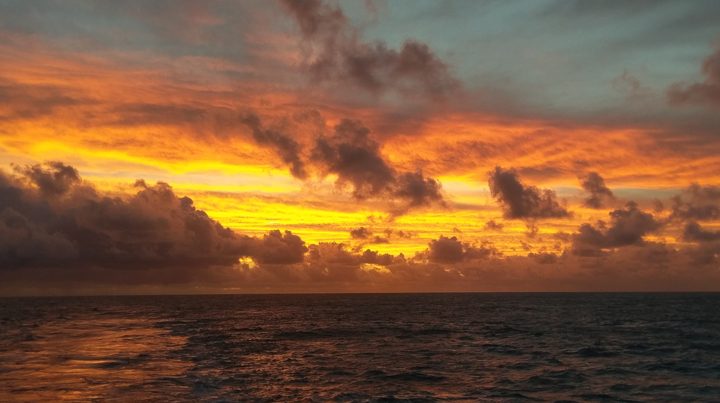
Two sunset photos with slightly different states of calm and cloudiness. Credit: Mike Novak/NASA
The ship ran out of vegetables and fruit several days ago and having a fresh garden salad is something I dream about. I miss my wife and my family. I miss our garden and our house. I miss feeling the damp earth under my feet and feeling the green grass between my toes. I miss the sounds of birds, insects, and animals scurrying through the forest. I miss going to concerts, museums, and making music with friends.
There are many musicians on board, including myself. I try to sneak away for ten minutes here and there to strum my classical guitar and work on new and old songs. We get together and play sometimes as well. It is difficult to find a place that is quiet enough where we don’t disturb other people. However, we were lucky enough to have a jam session out on the bow on one afternoon when the wind and waves were fairly calm. Being surrounded by the sea with the sun on my face is a great inspiration for music!
The boat has giant diesel engines and there is no way to escape their thunderous roar. The repetitive nature of this work is challenging. Every day I follow a similar schedule of working, eating, exercising, and sleeping. There are no days off and there is always more work to be done.
Despite all the hardships of rocking on the seas for 40 days, I feel that our work has great meaning. For several decades, the science data collected on these repeat hydrographic research cruises has been analyzed and published in peer reviewed papers. The breadth of knowledge that comes out of this program and the previous ones that it is built upon contributes to understanding the bigger picture of how the ocean ecosystems are responding to the changing ocean and atmosphere. The work that we do here, and what other have done in the past, will help us to understand and mitigate the problems of future.
Muffin O’Clock
Through Einstein’s Theory of Relativity, it was discovered that time is not a static measurement, rather it is relative to the observer. Somewhat similarly, time becomes both integral and meaningless while on a boat, completely relative to the scientist’s schedule. Time is integral to the individual with their stopwatch waiting for the precise second in which they can stop their experiment. On the other hand, we have been on a ship for 22 days where weekends are only a fleeting memory and days of the week hold no meaning. How can one keep track of the day?
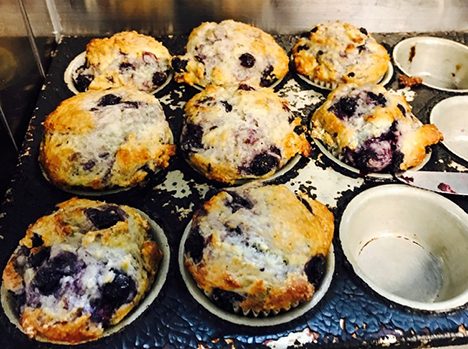
A fresh tray of blueberry muffins serve on board the R/V Atlantis
Food. While some view meal times solely as a source of nourishment, meals provide one of the only consistent ways we can keep track of our day on the ship. For example, at approximately 6:00 am every day, the cooks will place a freshly baked pastry of some kind in the galley. This is deemed muffin o’clock and you will often hear excited whispers and guesses around 5:30 a.m. on what could they be cooking up next. Biscotti, muffins, coffee cake, and scones are just a few of the impressive things the cooks on the Atlantis, Mark and Carl, have served at muffin o’clock. This is followed by breakfast at 7:30, lunch at 11:30, cheese o’clock at 3:00, and dinner + dessert at 5:30. For clarification, cheese o’clock is when cheeses, crackers, and sometimes smoked fish are placed in the galley where scientists and crew can feast together.
Food alone can not keep a ship full of sleep deprived scientists being productive. One of the most cherished traditions on the ship, in my humble opinion, is Coffee Club. I can not trade mark this, for there are a variety of coffee clubs on the ship that meet in a variety of locations and at various times. Science, politics, and religion are all fair game at these times of replenishment and all are welcome. When you see an individual with incredibly dark bags under their eyes but a little pep in their step, you can trust they just finished with coffee club and are about to be productive.
Living and working on a ship for 25 days straight is an incredible, rewarding, and often strange experience. Thankfully, the amazing scientists, crew, and cooks work together to create a fantastic environment so that exciting discoveries can be made in the air and sea.
P.S. If I didn’t make it clear enough, special thanks to Mark, Carl, and Tanzy for the amazing meals and clean-up!
Written by Savannah Lewis

A drifter decorated in illustrations of plankton organisms
Almost a month at sea. It’s not the first time. I have been at sea several times in these years but every time is special and unique. It is unique for the research we conduct, for the people we meet, the seas we cross, and the infinite things we still learn from each other at the most odd hours of the night. Yes, night! Nights are a big thing in plankton research. Collection, sampling and setting up of the experiments need to be done all before sunrise to prevent alteration in phytoplankton florescence as response to sunlight. The lab starts getting crowed at 1.00 AM when the first biological cast goes down to collect our precious tiny planktonic friends. I run upstairs to the galley for a quick cup of coffee and, maybe, a super fast PJ. Others are already in the galley enjoying the dinner that was put aside for them by our excellent cooks. I say good morning, we look at each other, we laugh. I run downstairs to the lab, the CTD is on deck. My colleagues and I gather all our bottles and containers and go out to collect the water to start measurements and experiments. All the water manipulations are done under dim light and since we crossed the 48°N, at very low temperature (11°C) to avoid plankton a temperature shock. We freeze but at least our creatures are happy! We start the music, bottles are filling up, a dance move contagiously run thru the lab as a remedy to the cold, we all move (some more then others) and chat and discuss each other’s ideas, methods, or sleeping troubles. Time to incubate the bottles. We call the bridge: “Hi, this is Françoise, Gayantonia, Sean and I are going to the back deck incubators, I’ll call you when we are back”. We are at sea after all, the ship is moving fast, the waves are splashing the deck, the wind is blowing and you sure want someone to know that you are out there!
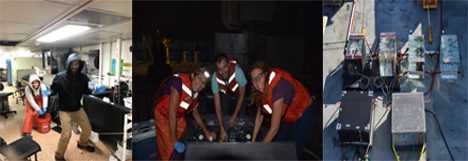
Photo collage of the incubation team.
We meticulously place the bottles in the incubators based on six selected light levels that plankton communities experience in the water column. We tie up the bottles, and strap down the incubators. All wet and cold we go back to the lab, the initial analysis needs to be run, no time to stop. After a couple of hours, when cold, lack of sleep and hunger start to build up, Ben shows up with a plate full of muffins or pieces of apple cake or some other delicacies the cooks decided to prepare for us “night watchers”. We all stop for 5 minutes, we enjoy our second breakfast, and if the morning is clear I go out to experience some of the most amazing sunrise I have ever witness. Then, full of beauty and new energy, I go back in to finish up, just in time for the third (and real) breakfast!
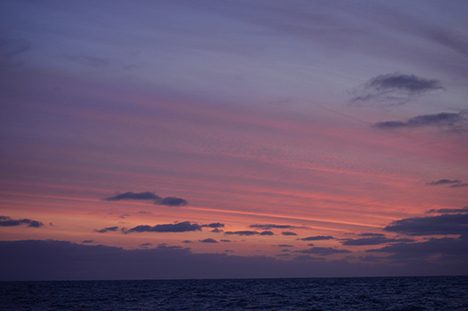
One of the many beautiful sunrises seen on board the R/V Atlantis during NAAMES III.
It only 8 AM, the day is still long ahead of us, measurements, analysis, cleaning. It’s 12 PM, I remember I signed up to help launching one of the atmospheric balloons that collect data on wind speed, humidity and temperature. I run to the second deck, the launch is perfect, the balloon rises up in the sky but wait…did we prepare the 180 tubes for chlorophyll?!?!?!?
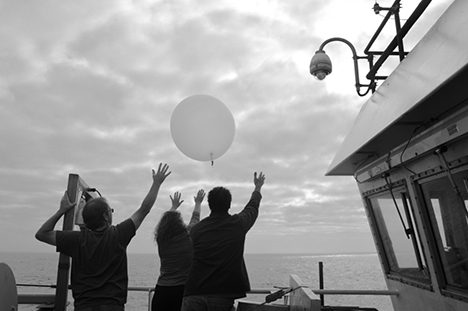
Launching of a radiosonde, an balloon driven sensor that measures atmospheric conditions.
Written by Gayantonia Franze
Tumbling along like a tumbling tumbleweed
Ok, so the title might just have outed my love for all things Lebowski, but hopefully I will be able to make a link, irregardless of how tenuous it might be, between tumbleweeds and and the subject of this post, drifters.
First things first, we have to remind ourselves what is a drifter, and how does it differ from a float. First, drifters float and floats sink, yes, this is correct, floats sink, drifters don’t. Drifters, or more precisely, passive Lagrangian drifters (PLD), are the kind we deploy during NAAMES in the North Atlantic. These are basically big bobbers which are “anchored” to the surface ocean by an amalgamation of fabric (at times brightly colored in pink camouflage), metal and plastic that is called a “holy sock drogue.” Maybe a picture will help, with the visual aid of me in the holy sock drogue.
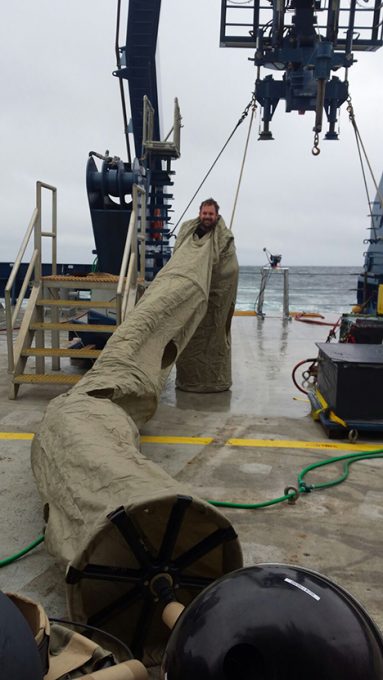
Peter Gaube inside a drifter. The “sock” is about 10 m long and helps to anchor the drifter into the ocean surface currents.
Ok, so what do these drifters do? Think of them as a breadcrumb trail that we drop and leave behind the boat. We drive this big ship through the ocean and choose what might seem to be random spots to stop and sample. The truth is these spots are not random. They are the result of the integration of lots of satellite observations, and at times, data we get from the floats (that sink), all which help us decide where we want to sample. Once we arrive “on station”, we drop three of these drifters. I’ll go into details as to why we drop three of them later, but for now, think of this as the breadcrumbs we drop to mark the water mass where we have sampled. Since the ocean is always moving, the drifter moves along with the surface layer of the ocean and allow us to follow them in time in order to stay with the same “water mass” that we initially sampled. During the NAAMES project, we also have a big airplane that samples not only the air, but also shoots a laser into the ocean to measure phytoplankton from the surface to about 50 m. Using the drifters, the plane can sample the same water mass that we sampled with the ship a few days prior.
So why drop three of the $3,000 drifters at once you may ask? Well, these drifters allow us to measure something that is actually really hard to measure in the ocean, that is diffusion. Diffusion is basically how fast do things spread apart, and how does this “rate of spreading” change based on where we dropped the drifters. Together with other members of the (Sub)mesoscale Group, we will use the rate at which these drifters spread in time to estimate how mesoscale eddies influence the diffusion of the oceans surface waters. To do this, we get hourly updates on the positions of all the drifter and compute the evolution of the area between the three drifters over time. All this fun stuff won’t get analyzed for some time as we need to allow enough time for all the drifters to spread apart.
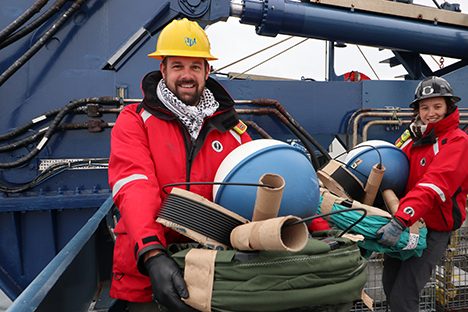
Deploying drifters is fun! The (Sub)mesoscale Group is all about having fun while doing cutting-edge science.
In addition to dumping drifters on station, Ali and I have designed a few diffusion experiments. We deployed (fancy word for dumped) triplicate drifters: outside of eddies, on the edge of eddies, at the point in the eddy where currents are at a maximum, and at the eddy center. This will allow us to compute how eddies influence diffusion and compare how the impact of these eddy varies between cyclones and anticyclones (i.e., the cold and warm core eddies).
But enough with all this science, we also have fun. It’s cool to deploy drifters as it’s a neat feeling to put out an instrument that talks with a satellite every hour for the next few years! For example, we deployed drifters in the middle of a warm core ring, which is a really big and strong eddy that is shed from the Gulf Stream (see some details about our warm core ring project here). One of these drifter stayed in the ring for a few days making larger loops around the eddy. In addition, superimposed on the big loops, were small little loops that are the result of what we call inertial motions. Basically, because the Earth rotates, surface water in the ocean oscillates in little circles all day, every day. After a few days, the drifter was spit out of the eddy and started heading clear across the Gulf Steam. The resulting drifter track was a very pretty pattern reminiscent of a rose.
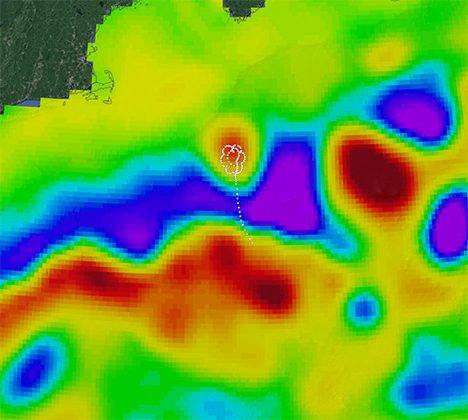
A drifter traces a rose in a warm core ring.
To wrap up, drifters drift, just as the proverbial tumbleweed, allowing us to follow a mass of water to sample with the ship and plane. Sometimes the patterns made by the drifters are really pretty, like our rose.
Written by Peter Gaube
Cloud formation depends on several factors, and one of those is the presence of aerosols. Marine aerosols come from a number of sources (sea salt, biogenic aerosols, continental aerosols that are carried over by wind) and differ in size and composition. We’ve collected CCN and CPC data to determine, respectively, the concentration of particles that activate as cloud condensation nuclei at various supersaturations, and the concentration of total aerosols encountered across the RV Atlantis’s path over the course of NAAMES III.
Marine air is relatively “clean” and contains fewer particles per cubic centimeter than continental air. The number of particles changes during certain events: for example, the North Atlantic phytoplankton bloom (the reason we’re all here) may result in an increase in aerosol production. Wind blown in from continents can also increase aerosol concentration. Rain, on the other hand, may decrease aerosol concentration as particles are scavenged by falling water droplets.
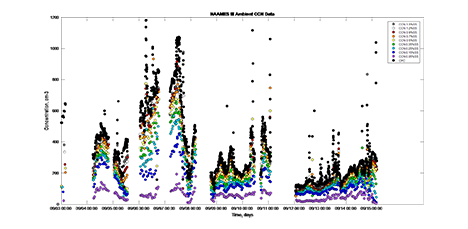
Preliminary results for aerosol concentration (CPC) and cloud condensation nuclei concentration (CCN, various supersaturations) for unsized data from NAAMES III.
Our preliminary results for aerosol concentration (CPC) and cloud condensation nuclei concentration (CCN, various supersaturations) are shown above for unsized data from the current NAAMES cruise. The fraction of aerosols that activated as CCN are shown in the plot below. This data also consists of unsized aerosols, so differences in activated fraction could be the result of particle diameter, chemical composition, or both.
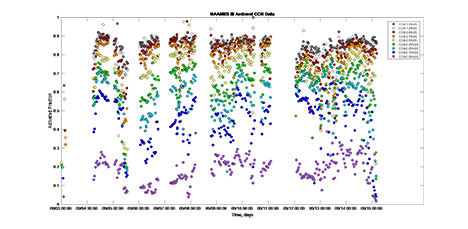
Preliminary results for the aerosol activated fractions from NAAMES III.
Over the next few months, we will pair quantitative aerosol data with weather observations, aerosol composition analysis, and biological/oceanography measurements in order to determine why changes in particle concentration and activation were observed over the course of the bloom.
Written by Jessica Mirrielees